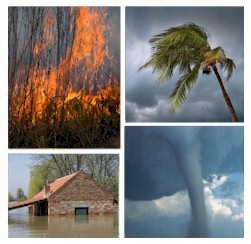|
|


Emergency Broadcast Systems
 This section of our technical library presents articles written about Emergency Alert Systems and Disaster Recovery definitions, terms and related information.
This section of our technical library presents articles written about Emergency Alert Systems and Disaster Recovery definitions, terms and related information.
The 911Broadcast emergency notification and alert service can deliver a large number of phone calls using a network of phone systems employing digital phone lines simultaneously. Should a disaster such as a snow storm, wild fire or flood hit your area, 911Broadcast systems can alert your community quickly providing specific instructions if an evacuation is required.
This service is available using our emergency broadcasting systems. If a dangerous chemical spill occurs in your community, you can target specific areas to call. If a severe snow storm hits your area, your community can be notified of school closings or event cancellations.
Wyoming DOT Avalanche Warning System
Reprint: ops.fhwa.dot.gov
US Highway 189 near Jackson, Wyoming is a steep, mountain road that winds through Hoback
Canyon. Along the highway, there is an avalanche path with a 35-degree slope that poses a
threat to the traveling public and to Wyoming Department of Transportation (DOT) personnel
engaged in snow and ice control activities. In the past, maintenance personnel have been
caught in avalanches while clearing snow and debris from a prior slide. The DOT has deployed
a warning system on the highway to detect avalanches, warn approaching motorists, and alert
maintenance personnel working in the area.
System Components: The avalanche warning
system is comprised of a sensor assembly, a
radio communication system, a controller, two
static warning signs equipped with flashing
beacons, and audible alarms in maintenance
vehicles. The sensor assembly includes tilt
switch sensors enclosed in galvanized steel
pipes. The pipes are hung on weighted wire
ropes attached to a ¾-inch (19-mm) diameter
cable, which is strung across the slide path.
The cable is suspended roughly 8 feet (2.5
meters) above the ground and anchored to
steel posts embedded in concrete. The
sensor assembly is installed 980 feet (298.7
meters) above the roadway.
The controller monitors sensor status, records sensor data, and activates warning systems via
radio when the onset of an avalanche is detected. The roadside warning signs are located
1,300 feet (396.2 meters) in advance of the affected highway segment. Batteries with solar
panel chargers supply power to all field sensors, control devices, and communications
hardware. Portable alarm devices are placed in maintenance vehicles—primarily rotary
snowplows and front-end loaders—operating in the area.
System Operations: Controller software is programmed to continuously monitor the sensor
assembly and detect switch closure based upon established threshold values. When an
avalanche is detected, warning devices are instantly activated. Tilt switches within the steel
pipes pivot from vertical to horizontal positions when impacted by a slide causing a circuit to
close. The controller automatically prompts a radio to transmit a modulated tone to activate
beacons atop motorists warning signs and to sound 97-decibel sirens in maintenance vehicles.
The audible alert gives maintenance personnel about ten seconds to move out of the slide path.
Transportation Outcome: The avalanche warning system improves roadway safety by
minimizing risks to drivers and to maintenance personnel. The system also facilitates timely
inspection of the roadway after an avalanche, snow and debris removal activities, and road
closure or rescue operations.
Implementation Issues: The warning system project was initiated as a multi-state, pooled fund
study involving Colorado, Idaho, Utah, Washington State, and Wyoming. After developing
equipment requirements, designers of the Wyoming system decided where the sensor
assembly should be installed based upon starting zones and slide speeds of prior avalanches.
If sensors were located too far above the highway, the system could initiate warnings for
avalanches that did not reach the road. If placed too close to the road, there would not be
sufficient time for the system to warn those in danger.
Designers considered system expandability through the integration of new components. A
preliminary test of non-invasive avalanche sensors is underway. Two geophones, which
measure ground motion, were installed adjacent to the slide path roughly 98 and 197 feet (30
and 60 meters) below the tilt switch sensor assembly. When the tilt switch sensors are
activated, the controller simultaneously samples the geophones. By detecting the time lag in
the arrival of an avalanche waveform, the controller can distinguish avalanches from other
events and determine slide velocity. Further experimentation is necessary to establish criteria
for warning system activation.
In a coordinated effort, local winter maintenance managers and emergency managers plan to
examine hardware and communication interface reliability, document system operation, and
assess roadway impacts. Evaluation results will be used to optimize the system and
supplement training.
Contact(s):
- Leroy “Ted” Wells, Wyoming DOT District 3, 307-352-3000, leroy.wells@dot.state.wy.us.
- Rand Decker, University of Utah, 801-581-3403, rdecker@civil.utah.edu.
Reference(s):
- Rice, Jr., R., et al, “Avalanche Hazard Reduction for Transportation Corridors Using Real-
Time Detection and Alarms”, http://www.sicop.net/annals-paper%20total.pdf.
- Rice, Jr., R., and Decker, R., “A Rural Intelligent Transportation System for Snow Avalanche
Detection and Warning,” Transportation Research Record, No. 1700, p. 17-23, 2000.
- Thirumalai, K., “Rural ITS Applications for Snow Maintenance and Winter Hazard
Mitigation”, presented at the 5th World Congress, http://152.99.129.29/cdrom/1006.pdf.
Activating Your Emergency Broadcasts
DSC systems allow you to initiate an emergency broadcast using several methods. Because emergencies can arise at any hour of the day or night, we have provided these multiple techniques so that you are not required to staff a center 24 by 7.
- Emergency Control Center
- DSC provides an Emergency Control Center PC interface to our phone systems that manages one emergency phone dialer or an entire network of dialers. Our emergency control program runs either on your local dialer or on the network where your dialer resides. This program lets you download phone lists and emergency phone messages and initiate the emergeny broadcast.
This program likewise lets you configure your network or emergency dialers and produces reports on the performance of your system or network.
- Web Based Control Center
- Our web based emergency notification system lets you access a web page for managing and activating emergency broadcasts. After entering a secure user id and password, you can download phone lists and recorded emergency messages. Using a menu selection, you can select any phone list/message combination to be broadcast online and initiate the emergency alert.

- Phone Activated Emergency Dialing
- If you are not able to access the internet and use our web based emergency dialing interface, we allow you to initiate an emergency phone campaign using a simple touchphone into our phone system.
After properly validating your account id and password, the phone system lets you select a pre-recorded messsage (or record one while you are on the phone). It then prompts you to identify the list of phone numbers to be called (previously maintained under your account). Finally this phone program will let you listen to the message to be sent and inform you of the size of the list of numbers to be called as a final check. If everything is ok, then pressing a touchphone key activates the calling program.
- Computer Activated Dialing
- Our emergency notification network also supports computer and web connectivity using XML technology. Thus, emergency communication can be initiated from your website or computer by automatically sending our emergency phone system a message containing a list of one or more phone numbers and a message to be sent to these individuals. The message can be text (which is automatically converted to voice) or a voice file.
For further information, visit our Emergency XML messaging web page.
|




 This section of our technical library presents articles written about Emergency Alert Systems and Disaster Recovery definitions, terms and related information.
This section of our technical library presents articles written about Emergency Alert Systems and Disaster Recovery definitions, terms and related information.
